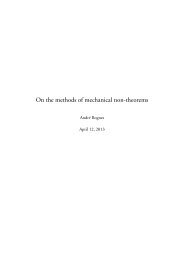The passive voice in written and spoken Scandinavian
The passive voice in written and spoken Scandinavian
The passive voice in written and spoken Scandinavian
Create successful ePaper yourself
Turn your PDF publications into a flip-book with our unique Google optimized e-Paper software.
This sentence is open to two <strong>in</strong>terpretations, one <strong>in</strong> which skadas, ‘damage-S’,<br />
atta<strong>in</strong>s a medial mean<strong>in</strong>g <strong>and</strong> one <strong>in</strong> which it has a <strong>passive</strong> mean<strong>in</strong>g. Hence, the<br />
sentence can be <strong>in</strong>terpreted as a mere ascerta<strong>in</strong>ment that the storehouse—for some<br />
reason or another—was damaged dur<strong>in</strong>g the w<strong>in</strong>ter. W<strong>in</strong>ter is simply mark<strong>in</strong>g the<br />
time period dur<strong>in</strong>g which the damage happened. Another <strong>in</strong>terpretation is to<br />
consider w<strong>in</strong>ter—that is, the harsh w<strong>in</strong>ter weather—as the cause of the damage<br />
<strong>in</strong>flicted on the storehouse. In this case we might consider the construction to be<br />
<strong>passive</strong>. Interpret<strong>in</strong>g the sentence <strong>in</strong> this way, one can add an explicit agent phrase<br />
(av), as suggested by Teleman et al. (ibid.):<br />
(11) Lagret har skadats av v<strong>in</strong>tervädret.<br />
the.storehouse has damage-S by the.w<strong>in</strong>ter weather<br />
‘<strong>The</strong> storehouse was damaged by the w<strong>in</strong>ter weather.’<br />
Accord<strong>in</strong>g to Teleman et al. (1999 Vol. II: 552–557), it is obvious that Swedish s-<br />
verbs are highly polysemous. In addition to the productive use of the above-<br />
mentioned mean<strong>in</strong>gs, the Swedish s-verbs can also be used with the so-called<br />
absolute function. Sentences with an absolute mean<strong>in</strong>g refer to events that the agent<br />
of the verb tends to perform. An example is given <strong>in</strong> (12):<br />
(12) Hunden bits.<br />
the.dog bite-S<br />
‘<strong>The</strong> dog tends to bite.’<br />
In Danish <strong>and</strong> Norwegian the absolute mean<strong>in</strong>g cannot be expressed by the s-verb,<br />
<strong>and</strong> sentences like the one <strong>in</strong> (12) have to be expressed with the lexical verb pleje,<br />
‘tend to’.<br />
In the current <strong>in</strong>vestigation, all uses of s-verbs other than <strong>passive</strong>—i.e.<br />
reflexive, reciprocal, medial <strong>and</strong> absolute—were left out. As just discussed, the<br />
borderl<strong>in</strong>e between medial <strong>and</strong> <strong>passive</strong> constructions can be fuzzy. In the event of<br />
uncerta<strong>in</strong>ty, a larger context was <strong>in</strong>cluded to determ<strong>in</strong>e the mean<strong>in</strong>g of the particular<br />
utterance.<br />
14

















